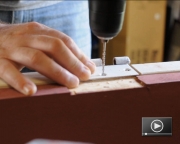- Error
{Re}habitat
Learn how adaptive reuse and upcycling can add hip design to your home, apartment, or yard with the Go Green channel's {Re}habitat series. Follow host Rachael Ranney as she shows you how to repurpose salvaged and found materials, adding fun and function to your space without breaking your budget.

Have a leaking toilet? Fixing it is easier thank you think. Watch our easy solution to a leaky toilet in Sixty Simple Seconds.
Finding water all over your bathroom floor from a leaky toilet is never a good situation. Fortunately, fixing the leak is only a few flushes away. One of the most common causes of a leaky toilet is the wax ring that sits between the toilet and the drain. Replacing a leaky wax ring is a quick DIY project that should be done when you first notice the leak. Watch this episode of 60 Simple Seconds for a quick look at how to replace a wax ring and fix that leaky toilet.
Replacing an old wooden door is an easy afternoon DIY project and you probably have the basic tools required. Watch our easy solution in Sixty Simple Seconds
Exterior wooden doors are subject to weather extremes and often deteriorate long before the door frame. Rather than tear out the entire door and frame, you can replace the old door by matching up the existing hinges on a new door slab and installing it on the existing frame. Watch this episode of 60 Simple Seconds for a quick look at how to replace a wooden door.
Replacing old appliances really can save energy – and money. How much money? These calculations, based on Energy Star labeling, help you find out.
Over the past decade, many Americans have seen the need to reduce their energy consumption. Some people have chosen to pursue this lifestyle change in order to live green and save the planet. In many cases, though, this reduction in energy consumption is driven by the savings that can be achieved by decreasing energy costs. Opportunities to deliver these energy savings occur throughout a home: replacing old appliances with new ones can create a significant return on investment (ROI).
House of the Month: Kent House by Gray Organschi Architecture
Written by Murrye Bernard Thu Jan 26 2012A second home in Connecticut features an earthy materials palette that is detailed to look clean and contemporary.
Architect Alan Organschi’s experience as a cabinet maker and carpenter colors his firm’s thoughtfully detailed designs, which celebrate materiality. He believes this hands-on approach has set the ethos for his practice, Gray Organschi Architecture, which he founded with partner Lisa Gray in New Haven, Connecticut. The duo has designed a range of institutional, commercial, and residential projects, such as the Kent House. The design of this home exemplifies the unique balance the firm has achieved between functional and bespoke.
Arc fault circuit interrupters (ACFIs) de-energize circuits when an arc fault is detected, preventing overheating and possible combustion. ACFIs enhance safety in any home and are required for some new construction, varying by state.
Over the past decade or so, a discussion about arc fault circuit interrupters and their required use in residential construction has raged among officials, organizations, corporations, and individuals related to the construction industry. Change can be difficult but “only the wisest and stupidest of men never change," as Confucius said. Change has occurred consistently in residential electrical systems since Thomas Edison unveiled the first electric light on New Year’s Eve, 1879. Knob and tube, cloth-braided, PVC-jacketed, two wire then three wire, fuses then breakers… the list goes on and on. Change happens. Most of that change can be attributed to our steadily increasing understanding of electricity since we were first electrified. With its increasing use in our homes, and the considerations of inhabitants’ safety and the prevention of property damage, it is not surprising that regulations have continued to change. So why do we resist? We should expect change and grow with it, particularly when it is in the interest of our own safety and can prevent the loss of property.
Natural ventilation occurs when air enters soffit vents, travels unobstructed along the underside of the roof deck, and exits through a ridge vent, gable vent, and/or hat vent. Mechanical ventilation that is temperature-controlled is also effective at reducing heat buildup inside an unconditioned attic space. Proper natural ventilation can be achieved by following the U.S. Department of Housing and Urban Development (HUD) "Minimum Property Standards" (MPS 403-3):
In addition to sealing air leaks, properly ventilating, and adequately insulating, the next time your roof is replaced you should consider installing water and ice dam protection along the eave as opposed to standard underlayment. Waterproof membranes are required for new construction by the 2009 International Residential Code (IRC) for asphalt shingle roof systems installed on homes that have a history of ice damming. Water and ice dam protection, or what is known by roofers as self-adhering, modified bitumen membrane, should be installed along the eave, atop the sheathing, extending at least 24” up the roof surface past the exterior wall line of the structure. It should also be installed inside valleys, along rake edges, and around flashed penetrations. Self-adhering, modified bitumen membrane is virtually impermeable, meaning water cannot pass through as a vapor or a liquid. It is important that any interior exhaust systems direct humid air to the exterior side of the roof and that all passive functions within an attic (ventilation and insulation) be proper and adequate. Should they be inadequate, or should air leakage occur, condensation could develop on the underside of the sheathing where water and ice dam protection is installed, and a different series of moisture problems would persist.
Air leaks, or what are commonly known as drafts, occur at penetrable locations along a ceiling, beneath an attic. Common locations where air has the ability to leak into an attic include gaps between sheets of drywall; holes through which wiring runs; and around an attic hatch cover, a chimney, recessed lighting, or plumbing and mechanical vents. During the colder months, as heat rises through your home, these gaps will allow warm, humid air to circulate into the unconditioned attic. Locating and sealing these leaks will prevent a rise in the ambient temperature of your attic. Energy Star has developed a helpful guide, “A Do-it-Yourself Guide to Sealing and Insulating with Energy Star,” that provides information about what materials, precautions, and methods are necessary to seal attic air leaks.




